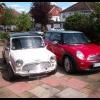As part of the series marking 50 years of British Leyland, Keith Adams picks through the numbers and recalls the views of the major players, to describe fully the merger between Leyland Motors and British Motor Corporation.
Fifty years ago, the deal was laced with optimism – some extracts from the article below on how it looked in January 1968......
The merger certainly created a large and chaotically overlapping range in places. In 1968, it looked like this: Mini, MG Midget, BMC 1100/1300, Wolseley, Jaguar E-type, Daimler 2.5 litre, Triumph 1300 to the 2000, the Spitfire and TR5 sports cars, and Rover’s 2000, the newly-engined 3.5-litre V8 saloons and the Land Rover.
British Leyland’s commercial vehicle operation accounted for three to four times the value in earnings of its main British competitors. With so extensive a range of models – small, medium and large saloons, sports cars, semi-luxury and high-performance cars, as well as engines of four, six and eight cylinders, ranging from 850cc to 4.3 litres – BLMC would cover virtually every section of the car market.
BMH’s top-selling cars in the UK were all in the front-wheel-drive series, the Mini leading in 1967 with 190,000 built. Second came the 1100/1300 series, of which 155,000 were produced – after holding number one place for three years in the UK sales charts. Third place was still held by the BMC Farina models (Austin A60/Cambridge, MG Magnette, Morris Oxford, Riley 4/72 and Wolseley 16/60), accounting for 35,000.
The numbers rapidly dropped from this point, showing clearly how dependent BMC had been on low-profit vehicles. Its fourth best-seller was the BMC 1800 (Austin, Morris and Wolseley), selling 34,500 in 1967. Austin-Healey and MG sports cars accounted for 45,000 sales, the long-lived Morris Minor for another 38,000, with Mini vans and small commercial vehicles adding 92,000
On the Leyland front, the Triumph Herald range led with 33,000 sales in 1967, almost equalled by the front-wheel-drive 1300 saloon, followed by the 2000 (20,000), the Vitesse (7,000), Spitfire, GT6 and TR5 sports cars (28,500). Rover produced nearly 35,000 cars (the Rover 2000 and 3-litre saloons), and about the same number of Land Rovers, while Leyland truck production added up to around 26,000 units.
At the time of the merger, the Mini was eight years old and the 1100 was five years old. The much-vaunted BMH 1500, was already shaping up to be a commercial flop. Building up a new range of models would take at least five years. Integrating the companies was likely to take a long time as well. The merger pointed the British vehicle industry in the right direction on what was probably the only road to survival against the American and European giants.
But it was no easy road. And it was likely to be some years before the country, in terms of vastly larger exports, and the shareholders, in terms of consistently bigger profits, reaped the rewards. In other words, even on the day of the creation of BLMC, the new company’s future looked far from certain…
The Full Story on AROnline:-
https://www.aronline...erger-happened/













